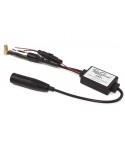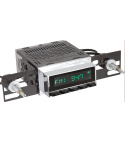What is Digital Audio Broadcasting (DAB+)
By now, you’ve probably heard about DAB and DAB+ which stands for Digital Audio Broadcast and has gained traction in much of Europe. If you’re located in the United States, you might not know much about it and our closest comparison is the adoption of the HD radio format which also utilizes a digital signal. We wanted to provide a brief explanation on this technology that is being incorporated into our radios designed for the international market.
In a nutshell, DAB+ is the improved version of the initial DAB signal that was initiated as a European research project in the 1980s. In the same way that analog television signal was overtaken, radio frequencies are being improved upon with new digital formats. This improvement began with the Norwegian Broadcasting Corporation and has evolved into today’s DAB+ format which utilizes an AAC+ codec that improves sound quality, offers more listening choices, and on average can operate with a weaker signal – meaning less static. The US approved the use of HD radio in 2002, a similar format, which has been utilized and marketed across the industry as a supplement to traditional AM/FM tuners.
Though HD and DAB+ utilize similar signals in their respective markets, DAB+ has been gaining more traction due to the European mandate that analog FM be phased out in favor of this new technology which will save costs and also help the development of the commercial DAB+ network.
So what are some of the highlights of this new technology? Well, as we mentioned above, the DAB+ signal offers a better sound quality over that of traditional FM frequencies – we could get into the specifics of these comparisons but in layman’s terms, it’s more robust. In addition to this improvement, the digital signal also allows for more station options to be transmitted by way of the signal which provides listeners a greater variety of broadcasts to choose from. The digital signal produced by DAB+ is also an improvement in that receivers can work off a much weaker signal which can also be reflected from the terrain – meaning that this system requires fewer towers to effectively cover a given network. All in all, the DAB and DAB+ networks are meant to be a free, stable and more accessible improvement over the analog signals listeners have experienced for years.
While currently Norway is the only country to have completely shut down it’s FM network the rest of Europe isn’t expected to be far behind. Many listeners will need to purchase an adapter in order for their older radios to work with this new network, however many high end audio manufacturers have been building this technology into their radios for a few years now. If you’re one of our international customers and you’re looking to upgrade to a DAB+ unit, reach out to us today – we currently offer two DAB+ models for export markets.




